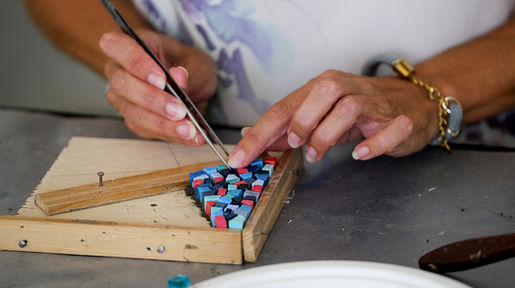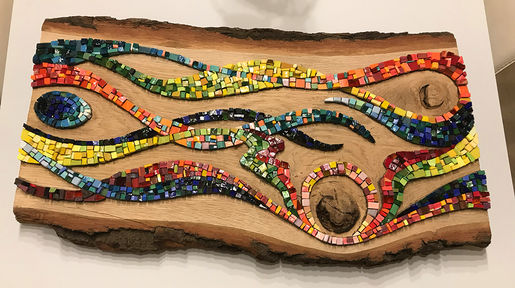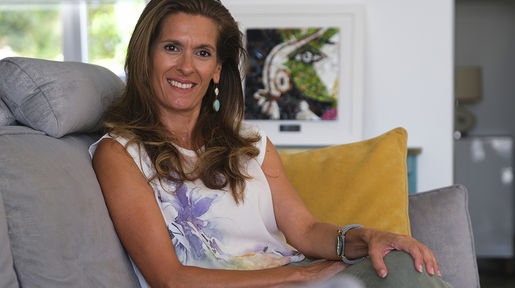Art Scene
SEARCH BY CATEGORIES
November 24, 2022 – Published in Design & Decor Autumn-Winter 2022 issue
Composing mosaic art from fragments of colour – Dorianne Cachia
Words Shirley Jobson
Photography Jonathan Borg & Dorianne Cachia
Somewhere in Birkirkara, there is a house with a central courtyard featuring an eye-catching mosaic on its floor, painstakingly created by its previous owner.
In her present home overlooking one of Malta’s scenic bays, the
gifted artist continues assembling tiny colourful tesserae to make mosaic art pieces in her studio.
Meet Dorianne Cachia, a qualified architect and accomplished mosaic artist!
“I have always been fascinated by glass,” revealed Dorianne, recalling her childhood. “While my siblings were swimming, I would be on the beach collecting the vivid pieces of glass that existed at the time and, later, assembling them into small mosaics. I took up painting as a hobby in later years, and I invariably used pixellation in my art. Somehow, I look at things as a composition of smaller parts, and that is one of the reasons why, nowadays, I express myself through mosaics as my favourite medium.”
As an architecture student, Dorianne was captivated by the mosaic world of Antoni Gaudí.
She was immediately taken in by the vibrant colours, rich textures, reflections, and fantastic compositions. “As I immersed myself into this world of coloured tesserae, I decided that, when we bought our family home, I would make a mosaic inside. That is how I found myself experimenting on our former courtyard. I spent the first hours placing the pieces in-situ, but then I realised I would not achieve a perfectly level surface, so I scrapped the whole thing and went back to the drawing board.”
“Being a creative and an architect results in me having a reliable balance of art and science as well as relevant exposure to materials and techniques. I soon realised I needed a different approach. To ensure one level surface, I adopted what I later learnt was called ‘the double reverse method’, whereby I stuck the pieces face down on brown paper using water-soluble glue, flipped them over and set them onsite, poured water to dissolve the glue, peeled off the paper – and voilà! It was ambitious and crazy, and it took me a whole year,” she laughed, “but it was an experience that spurred me to experiment and delve deeper into this fantastic artform.”
For a number of years, however, Dorianne shelved this budding passion for mosaics, until a trip to Ravenna, Italy – along with fervent encouragement from her husband – reignited the spark.
At the same time, she came across the smalti, a Venetian handmade, richly coloured, thick enamelled glass. This, in turn, led her to the Scuola Mosaicisti del Friuli – the best in the mosaic world – in the Italian town of Spilimbergo. She immediately signed up for a short course, where affirmative feedback about her handiwork spurred her on.
Just like architecture, mosaic-making is a process requiring pre-planning and groundwork, but it is simultaneously unbound.
Mosaic art is a free art involving careful preparation regarding the individual tesserae, the spaces in between, the shadows each piece casts on the other, the massing, the sculptural effect, the texture, the contrasts – and, of course, the colour palette! Mosaics are also built piece by piece just like a building, but with none of the policy restraints found in architecture.
“What is so intriguing is that making a mosaic requires both the precision and dedication of jewellery-making and the boldness and tenacity of architecture. It is particularly close to architecture in that it opens a dialogue between the artist and the world, based on an interplay of colour, texture, light, shadow, and massing, accompanied by a knowledge of materials and mastery of technique, all pieced in with considerable patience. To me, it really feels like I’m painstakingly building boundless dream cities and landscapes, one tessera at a time, where one can get lost – or possibly be found.”
The Byzantine mosaics in Ravenna were built centuries ago with the same materials and methods used today.
Dorianne uses hand-cutters for the smaller pieces of smalti, along with the centuries-old technique of the hammer and hardie over a rectangular wooden block to cut the larger pieces of glass into the required sizes. “Like any art, the process of creating a mosaic varies. It can be spontaneous or planned. I can use the reverse technique I followed for the courtyard or the direct method, where I build and glue a pattern on a substrate, then finish off the sides and frame it. However, if I have a sketch, I need to follow the lines without covering them with glue. In this case, the sketch goes at the bottom, I place mesh in between, and I work over the netting, which allows me to be faithful to the design.”
As interest in her art grew, Dorianne introduced various collections, such as the Quadrilateral, Geo, Orbis (circular), and Osiris (eyes) compilations. Most of what she produces is wall art, but she is also experimenting with jewellery and sculptural work. Often, clients request a mosaic to present as a gift for others or for themselves, either choosing from her existing collections or trusting her with the freedom to design one herself.
“I love all my pieces and wish I could keep them all, but it is a pleasure to see them going to new homes, as I want more people to appreciate this artform – plus I would eventually run out of space,” Dorianne smiled. “It does involve a lot of work and patience, but it doesn’t take anything out of me. It is actually extremely therapeutic!”
Mosaics are not only vibrant, but they are also a tangible form of art.
“The versatility of smalti as well as the variety of their vivid shades is incredible. I’m very much in love with colour, which is another reason why I feel I can really express myself through this art – it is a celebration of colour. It also fascinates me how people feel the urge to touch mosaics, to feel the composition of pieces, and satisfy their curiosity.”
“Mosaics are often referred to as eternal paintings, because the materials do not erode or fade. In fact, archaeologists still unearth mosaics from Roman and Byzantine periods which are practically intact. They truly stand the test of time!”
Dorianne seeks to regularly attend short courses to gain inspiration, be exposed to new ideas, and acquire new techniques, because the local scene for mosaics is limited. “There are some very talented mosaic artists in Malta, but the influence is restricted. I really wish to promote mosaic art in Malta, not because I feel I have attained any mastership, but to inspire young people and generate interest in it as an art form.”
The enthusiastic artist has many dreams waiting to be accomplished when it comes to mosaics.
Dorianne has participated in a collective exhibition and presented two successful workshops in Malta. She also wishes to travel, meet and work with the big mosaic masters, exhibit more locally and abroad, but above all, continue exploring, experimenting, and creating.
“Mosaics bring a certain joy to the people who acquire them. Years later, they still tell me they spend time appreciating the piece I devised and the work that went into cutting and positioning every single fragment. It gives me a sense of purpose to know I am transporting colour into their homes. I certainly hope to inspire many others in Malta to familiarise themselves with mosaic art and acknowledge it as a stunning form of art!”


























